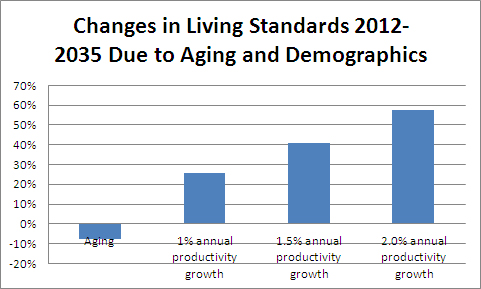January 17, 2013
Thomas Edsall devotes his blog post this week to Walter Russell Mead and a number of others who tell him that demographic change is going to wipe out the welfare state. The problem is that the projections don’t support this story. The impact of projected future demographic change on the budget is actually fairly limited.
In 2001 Social Security cost 4.1 percent of GDP (Table F-5). It current costs 5.1 percent of GDP (Table 3-1). Over the next two decades the cost is projected to increase by roughly the same amount as it did in the last dozen years. That doesn’t seem like an insurmountable burden. In fact, if the projected shortfall in Social Security funding for the rest of the century were filled entirely through an increase in the payroll tax, the necessary tax increase would amount to 7 percent of projected wage growth over the next two decades and just 4.0 percent of the wage growth over the next 40 years. (This assumes that workers get their share of productivity gains, which is a key issue that has little to do with demographics.) The tax burden would be lessened insofar as part of the projected shortfall was filled by making the tax more progressive (e.g. raising the cap) or cutting benefits.
The rise in Medicare costs is projected to be larger, but this is due to the projected rise in per person health care costs, not demographics. (People don’t age any more rapidly in the Medicare program than in Social Security.) This emphasizes the need to control health care costs, which are already more than twice as much per person in the United States as the average for other wealthy countries. This ratio is projected to grow to 3 or 4 to 1 in the decades ahead.
It is wrong to refer to the projected explosion of health care costs as a demographic issue. It stems from an inability to confront the powerful lobbies (drug companies, medical equipment companies and doctors) who profit from the waste in the U.S. health care system. The actual impact of demographic change is swamped by productivity growth. It is probably also worth noting in the context of this piece that the ratio of interest on the government debt to GDP is near a post-World War II low.

Source: Social Security Trustees Reports and Author’s Calculations.
This blogpost also refers to the projected shortfall in state and local pension funds, telling readers:
“Dozens of city and state public employee pension plans are on the verge of bankruptcy – or are actually bankrupt – from Rhode Island to California; in 2010, a survey of 126 state and local plans showed assets of $2.7 trillion and liabilities of $3.5 trillion, an $800 billion shortfall.”
This $800 billion shortfall is less than 0.4 percent of projected GDP over the next 30 years, the time horizon in which most of these benefits are projected to be paid. That is less than one fourth of the increase in military spending associated with the wars in Iraq and Afghanistan or the additional money projected to flow to the pharmaceutical industry as a result of government granted patent monopolies.







Comments